



 Avanços
Avanços
O manuseio endoscópico de complicações traqueobrônquicas é um importante
aspecto do tratamento em pacientes com obstrução benígna ou malígna das vías
aéreas. Para a maioria destes pacientes, a dilatação endobrônquica, o debridamento
de granulomas e a colocação de
stents pode oferecer importante paliação e melhorar a qualidade
de vida.
No tratamento do cancer do pulmão, muito embora o comprometimento respiratório e cardíaco ainda limite a indicação cirúrgica, a extensão do tumor não é mais uma contraindicação absoluta. Ressecção após os 70 anos de idade não é uma exceção. Cirurgia para o "carcinoma não-oat cell" do pulmão tem resultado em uma sobrevida aos 5 anos em cerca de 60-80% dos pacientes nos estágios I e II. No estágio III estudos recentes têm demonstrado a efetividade da quimioterapia neoadjuvante pré-operatória que deveria logicamente ser proposta com ou sem radioterapia em pacientes com tumores ressecáveis.
A ressecção cirurgica de metástases pulmonares
e de mesoteliomas tem também sofrido considerável progresso. Infelizmente, exceto
por protocolos terapêuticos experimentais, a ressecção de carcinoma de pequenas
células não propicia qualquer efeito benéfico e desta forma não deve ser
proposto.
Indicações para cirurgia nos pacientes com
enfisema
tem sido bem sucedidas e se extendem além das clássicas indicações de ressecção
de bolhas compressivas. Em muitas situações pacientes com enfisema difuso podem
se beneficiar da redução do volume pulmonar antes de um transplante.
Transplante
pulmonar unilateral está indicado para fibrose pulmonar
doença pulmonar vascular e enfisema com uma sobrevida global de 50% aos 5 anos
e 43% aos 6 anos. O sucesso do transplante bilateral para fibrose cística ainda
deve ser determinado.
A VATS   Cirurgia Torácica Vídeo Assistida (Video Assisted Thoracic Surgery) é o mais recente progresso tecnológico aplicado à Cirurgia Torácica.
Endobronchial Management of Benign and Malignant Airway
Complications
Extended Operations for the Treatment of Lung Cancer
Lung Tumors Multidisciplinary Database
Extended Indications for Lung Volume Reduction
Surgery in Advanced Emphysema
Organ Transplantation
U. MICHIGAN
VATS    U.PITTSBURGH
índice
 Artigo Original
Artigo Original
Universidade Federal Fluminense
Niterói, Rio de Janeiro, Brazil
PATIENTS
Thirtyfour patients underwent pulmonary resections using folded pericardial patchs to reinforce "hand made" parenchymal sutures. The 15 male and and 19 female patients ranged in age from 10 to 75 years
(Mean 48.5). Indications for surgery included various diseases Table 1 and different types of resections were
performed Table 2.
TABLE 1 -
INDICATIONS FOR SURGERY
CAVITARY INFECTIOUS DISEASE n=2
Micetoma(2)
NODULAR DISEASE n=12
Adenocarcinoma(4)
Hamartoma(2)
Extrinsec alveolitis(1)
Tuberculoma(5)
OBSTRUCTIVE DISEASE n=8
Type I Bulla(2)
Type III Bulla+Emphysema(2)
Emphysema(4)
| (N) | Length of suture(cm)* | |
|---|---|---|
| Byopsies | ||
| Wedge | ||
| Atypical Segmentectomy | ||
| Wedge+Biopsy | ||
| Cavernoplasty | ||
| Bullectomy | ||
| Reduction Pneumoplasty |
TECHNIQUE
Pericardial doublet folded patchs®* are tailored from rectangles of low thickness bovine pericardium to fit both grasping claws of an autoesthatic clamp (Rochester type)
(Figure 1).
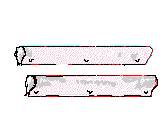
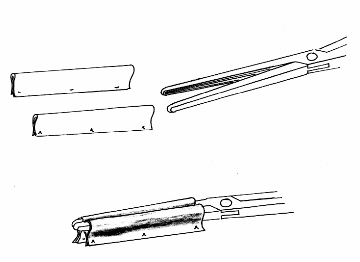
The folded pericardial patchs are used to sheathe the claws of the clamp which is than used to sandwich clamping of the lung parenchyma (Figure 2). Following pulmonary resection an horizontal suture is made using absorbable suture and involving successively pericardium, lung and pericardium (Figure 3).
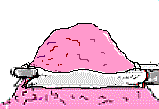
Figure 2 - Sandwhich clamping of lung parenchyma.
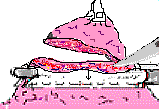
The clamp is then unblocked and gently removed with a retrograde movement. The procedure is completed with a continuous suture using the pericardial patchs to buttress the sandwiched cutted lung edge (Figure 4).
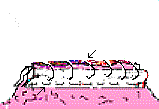
RESULTS
Immediatly after completion of the suture the "water test" did not show air leaks in 33 of the 34 patients through the suture line
(Mean Length=11.5cm; Range=6.5-24 cm).
In these 33 patients there was no postoperative air leakage and the mean drainage time was 1.3 days (Median=1; Range=1-3) and the mean postoperative
time was 3.9 days (Median=4; Range=2-5)Table 3.
TABLE 3 - RESULTS
| NO AIR LEAK
(N=33) | AIR LEAK
(N=1) | TOTAL
(N=34) |
|
|---|---|---|---|
| Length of Suture (cm) | |||
| Drainage Time (days) | |||
| Postoperative Time (days) |
COMMENTS
Postoperative air leakage is considered a common sequela of pulmonary resections.
When suturing the lung with fine needle sutures a point of diminishing return is reached after which the surgeon accepts a certain amount of leakage. This is better than producing new tears with repeated attempts at sewing over(3).
Stapling is a fine swift way of suturing the lung, though it is not clear if stapling produces a safer air stanching suture, inasmuch as the staples may not be allaways uniformily crimped, situation in which it is necessary the use of complementary safety manual stitches.
In routine pulmonary surgery air leakage of short duration lasting less than 4 days, is tolerated as an inevitable event. Prolonged air leakage lasting more than 5 days do occur after routine resections, however it is mostly common following surgery for emphysematous bullous disease(4).
The recent surgical retake of reduction pneumoplasty for emphysema was made possible safely and with low morbidity by the use of pericardial strips fastened to the stapler and than suited to buttress the suture line. This approach greatly reduced the incidence of air leakage in the fragile emphysematous lung tissue.
The corollary of the effectiveness of stapling with pericardium is the expectation of attainment of perfect results, i.e. "dimininished air leaks" if this technique is used routinely in pulmonary resections, as suggested by Urschell(2).
The folded pericardial doublet patchs that we report here produced extemelly safe sutures. Results shows a dramatic decrease in the occurrence of air leakage after routine pulmonary resections. Air leaks simply did not occurred in 90% of the cases. The overall mean drainage time was 1.7 days and the mean postoperative time was 4.3 days.
These times are significantly lower than those obtained after pulmonary resections using simple surgical sutures and/or stapling (Mean Drainage Time=5.4 days and Mean Postoperative Time=11 days)(5).
The effectiveness of the protection conferred by the folded pericardial patchs was experimentally confirmed performing sutures of "ex-vivo" lungs of dogs. The delicate and fragile dog's lung parenchyma don't accept neither manual nor mechanical sutures. Nevertheless reinforcing the suture with pericardial patchs results in perfectly air stanching sutures.
From a technological and practical point of view stapling with pericardium is the ideal technique due to the clearness and quickness with which the suture is done. However manually reinforcing the suture with pericardium does not depreciates the surgeon's activity for the time expent to perform the suture (10 to 20 minutes for a 15cm suture); time thus expended that represents significant savings in costs to attain an equal clinical benefit, i.e. decreased air leakage, decreased drainage time, decreased postoperative time and a more rapid convalescence.
Our results shows that "hand suturing" the lung with pericardium is a safe alternative technical way of preventing air leakage standing
for prompt and smooth convalescence from pulmonary resections. Incomplete convalescence due to air leakage of any intensity
is especially alarming to the patient and the family, distressing to the surgeon and expensive to the health care system.
So that it is needless further convincement or persuasion to accept that air leakage is a matter of major concern to patients,
doctors and those who pay the bill.
CONCLUSIONS
The use of the folded pericardial patchs technique to manually reinforce the lung suture line, produces safe air stanching parenchymal
sutures, resulting in a dramatic decrease in postoperative air leakage,
thus favoring prompt and smooth convalescence following routine pulmonary resections.
REFERENCES
NOTE:
Functional Improvement After Volume Reduction: Sternotomy Versus
Videoendoscopic Approach
Access the articles:
Prevention of Air Leaks After Pulmonary Wedge Resection
by/Cecil C. Vaughn, Ernst Wolner, Marcel Dahan et al.
Annals of Thoracic Surgery
by/Wilfried Wisser, Edda Tschernko,
Ömer Senbaklavaci et al.
Annals of Thoracic Surgery
(1)Cooper,JD et al.: Bilateral pneumectomy (volume reduction) for Chronic
Obstructive Pulmonary Disease
J. Thora. Cardiovasc. Surg., 1995, 109:106-19.
(2)Urschel,HC.: Bilateral Pneumectomy (volume reduction)[Discussion].
J. Thorac. Cardiovasc. Surg., 1995, 109:106-19.
(3)Vogt-Moykopf,I and Meyer,G.: Management of prolonged parenchymal air leaks and residual pleural spaces [Discussion]. In International Trends in General Thoracic Surgery, WB Sauders Company, 1987,2:392-3.
(4)Connolly, JE and Wilson, A.: The current
status of surgery for bullous emphysema.
J. Thorac. Cardiovasc Surg. 1985;97:351-61
(5)Thévenet, F et al.: Pneumothorax spontané et
récidivant. Traitement chirurgical - a propos de 278
observations.
Ann. Chir. thorac. cardio-vas., 1992;46:165-169
Universidade Federal Fluminense
Niterói, Rio de Janeiro, Brazil
A biópsia dos linfonodos contidos na gordura pré-escalênica, recomendada por Daniels (DANIELS, 1949) revelava a preocupação de se diagnosticar histologicamente doenças intratorácicas por meio de um procedimento cirúrgico de pequeno porte. A mediatinoscopia, proposta por Carlens (1959) resultou de um processo evolutivo da técnica de Daniels.
MATERIAL E MÉTODOS
Foram analisados os prontuários de 408 pacientes submetidos a mediastinoscopia no Serviço de Cirurgia Torácica do Hospital Universitário Antonio Pedro da Universidade Federal Fluminense e no Hospital Santa Cruz , da Sociedade Portuguesa de Beneficência de Niterói num período de 15 anos (1980/1995). Os 408 pacientes se distribuíram na faixa etária dos 15 aos 82 anos, a maioria do sexo masculino (64%) 310 pacientes.
A via de acesso cirúrgico utilizada no exame com maior freqüência foi a via cervical de Carlens, como se segue na Tabela 1:
TABELA 1 -MEDIASTINOSCOPIA. VÍAS DE ACESSO
| (N) | |
|---|---|
| MEDIASTINOSCOPIA CERVICAL | |
| MEDIASTINOSCOPIA CERVICAL E ANTERIOR | |
| MEDIASTINOSCOPIA ANTERIOR |
A mediastinoscopia foi utilizada para o diagnóstico de massas e linfonodomegalias mediastinais (n=125) , para o estadiamento do câncer de pulmão (n=278) e ainda para retirada de corpo estranho (n=1), estadiamento do câncer de esôfago (n=2) e para a drenagem de abcessos mediastinais (n=2).
Neste artigo foram analisados os prontuários de 125 pacientes nos quais a mediastinoscopia foi realizada com finalidade diagnostica. Os dados obtidos na mediastinoscopia , quando negativa , foram comparados com os laudos histopatológicos naqueles pacientes que foram submetidos a algum procedimento cirúrgico para esclarecimento definitivo do diagnóstico. Em 103 oportunidades, a via de acesso utilizada foi a cervical. A via anterior , isoladamente, foi utilizada apenas 7 vezes, e o acesso combinado (anterior + cervical) foi indicado em 15 mediastinoscopias. A idade mínima foi de 13 anos e a máxima 75 anos, 80 pacientes eram do sexo masculino, e 45 do sexo feminino Sempre que possível o material de biópsia foi também examinado por congelação durante o ato cirúrgico.
RESULTADOS
O carcinoma foi o diagnóstico mais freqüente (36,8%), seguido de linfoma (16%) e sarcoidose (14,4%) como demonstrado na Tabela 2.
TABELA 2 -MEDIASTINOSCOPIA. DIAGNÓSTICO
| DIAGNÓSTICO | (n) |
|---|---|
| Carcinoma | |
| Linfoma | |
| Tuberculose | |
| Timoma | |
| Adenite | |
| Silicose | |
| Blastomicose | |
| Tu. Cels. Germinativas | |
| Bócio Tireoidiano | |
| Dilatações Venosas Peri-esofagianas | |
| Fibrose Idiopática do Mediastino | |
| Hiperplasia Linforreticular |
Em 13 pacientes o diagnóstico mediastinoscópico foi de linfoadenite reacional . Em 4 destes pacientes o diagnóstico de linfoadenite reacional estava correto pois a investigação ou evolução subseqüente demonstrou o seguinte : em um paciente a biópsia de pulmão realizada no mesmo ato cirúrgico demonstrou o diagnóstico de granulomatose de Wegner (n=1) , num outro o próprio exame mediastinoscópico demonstrou a presença de fibrose intensa sugerindo o diagnóstico de mediastinite fibrosa , em outros dois a presença de alguns linfonodos maiores que 1 cm localizados na região paratraqueal em pacientes sob investigação clínica de febre , a evolução para a cura respalda o diagnóstico de linfoadenite reacional. Nos 9 outros pacientes consideramos o diagnóstico de adenite como falha do método uma vez que em dois pacientes não conseguimos estabelecer o diagnóstico definitivo pois os pacientes recusaram a investigação proposta. Nos outros 7 a investigação subsequente demonstrou o diagnóstico de tuberculose em 4 casos, silicose em 1 e timoma em 1. A incidência de falhas do método foi portanto de 7,2% ( 9 falências em 125 pacientes).
Nos prontuários dos pacientes submetidos à mediastinoscopia para o diagnóstico de massas mediastinais constatou-se que 11 pacientes, do total, apresentavam síndrome de veia cava superior o que não representou uma contra-indicação à utilização método.
As complicações que podem ser relacionadas com a realização do método foram: agravamento da síndrome da veia cava superior (1 caso), hemorragia mediastinal (1 caso, resolvida com tamponamento e eletrocautério) e enfisema subcutâneo (1 caso). Um paciente era portador de imagem radiologia compatível com massa mediastinal e a mediastinoscopia demonstrou tratar-se de dilatações venosas periesofagianas .
CONCLUSÕES
A mediastinoscopia é um método de diagnóstico eficaz nas doenças torácicas com envolvimento mediastinal, principalmente câncer do pulmão, linfoma , sarcoidose e tuberculose.É um procedimento seguro e com baixo índice de complicações quando executado por cirurgião torácico treinado.
BIBLIOGRAFIA
1. BRANTIGAN,J.W. & BRANTIGAN, C.O. Biopsy of non palpable scale-ne lymph nodes in carcinoma of the lung. Am. Rev. Resp. Dis., 107: 9622-74, 1973.
2. 10.CABEZAS, F.S. et alii. Mediastinoscopia: experiência en 150 casos. Rev. Chil. Cir., 2(40): 81-9, 1979.
3. CARLENS, E. Mediastinoscopy: A method for inspection and tissiue biopsy in the superior mediastinum. Dis. Chest., 36: 345-52, 1959.
4. DANIELS, A.C. A method of biopsy useful in diagnosing certain intrathoracic diseases. Dis. Chest., 16: 360-7, 1949. *
5. FERNADEZ, A. et alii. Mediastinoscopia: Aspectos técnicos e indicações atuais. Rev. Hosp. Clin. Fac. Med. S. Paulo., 49 (4): 164-7, 1994.
6. GINSBERG, R.J. Standard cervical and extended mediastinoscopy. In Shields T.W. Mediastinal Surgery, Philadelphia, Lea & Febiger, 1991.
7. JAHANGIRI, M. & GOLDSTRAW, P. The role of mediastinoscopy in superior vena cava obstruction. Ann. Thorac. Surg., 59: 453-5, 1995.
8. JÚDICE, L.F. Mediastinoscopia. In: Franco, C. A. de B. et alii (org.). Métodos de diagnóstico em pneumologia. Ars. Curandi, 17(4): 133-48, 1984.
9. KIRSHNER, P.A. Cervical substernal "extended" mediastinoscopy. In: Shields, T.W. (org.). Mediastinal Surgery, Philadelphia, Lea & Febiger, 1991.
10. LEWIS, R. J. et alii. Mediastinoscopy in advanced superior vena cava obstruction. Ann. Thorac. Surg., 32(5): 458-71, 1984.
11. LOB, M. et alii. L'intérêt de la mediastinoscopie avec biopsie ganglionaire pour le diagnostic de la silicose. Schwerz Med. Wschr., 97: 179-81, 1967.
12. OTTO, T. R. et alii. Experience with mediastinoscopy. Thorax, 27: 463-7, 1972.
13. PEARSON, F. G. Mediastinoscopy: A method of biopsy in the superior mediastinum. J. Thorac. Cardiovasc. Surg., 49(1): 11-21, 1965.
14.URSCHEL, J. D. & HORAN, T. A. Mediastinoscopic treatment of mediastinal cysts. Ann. Thorac. Surg., 58: 1698-701, 1994.


LUIZ FELIPPE JÚDICE
Professor Titular de
Cirurgia Torácica
UFF